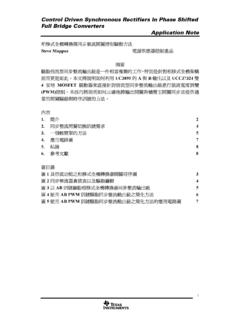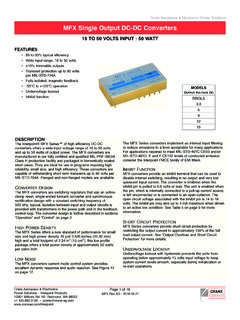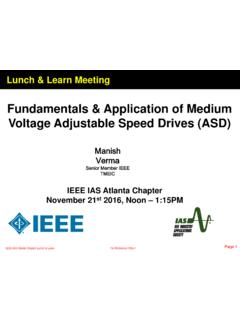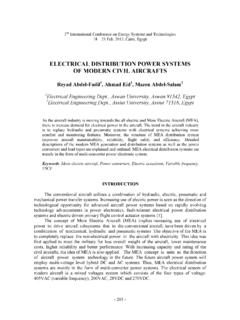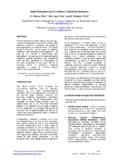Transcription of Optimizing MOSFET Characteristics by Adjusting …
1 1 IntroductionApplicationReportSLUA341 , , ,driverICsandPWMcontrollers, ,resultsinalowerassociatedon-resistance, RDS(on), ,loweringtheMOSFETon-resistanceisespecia llycriticalforthesynchronousrectifier, ,however, , ,ahighergatechargerequirementwillproduce longerriseandfalltimes, ,theappliedvoltageshoulddrivetheMOSFET gatessuchthattheaddedgatechargeandswitch inglossesarelessthanthepowersavingsgaine dbyloweringRDS(on).Forexample, DutyCycleFSW SwitchingFrequencyG1 ControlMOSFETGateDriveG2 SynchronousRectifierMOSFETGateDriveIG(si nk) DriverSinkCurrentIG(source) DriverSourceCurrentIOUT OutputLoadCurrentLLUMP DrivertoMOSFETP arasiticInductancePBD SynchronousRectifierMOSFETBody-DiodePowe rLossPC MOSFETC onductionPowerLossPD TotalDissipatedPower(G1,Q1,G2,Q2)POUT MOSFETO utputCapacitanceLossPRR SynchronousRectifierMOSFETBody-DiodeReve rseRecoveryPowerLossPSW mosfets witchingLossQG TotalGateChargeQRR Body-DiodeReverseRecoveryChargeQ1 ControlMOSFETQ2 SynchronousRectifierMOSFETRDS(on) MOSFETD rain-to-SourceOnResistanceRG MOSFETE xternalDiscreteGateResistanceRGI MOSFETI nternalGateResistanceRG1(sink)
2 G1 DriverSinkResistanceRG1(source) G1 DriverSourceResistanceRG2(sink) G2 DriverSinkResistanceRG2(source) G2 DriverSourceResistancetBDF MOSFETBody-DiodeConductionTime,SwitchNod eFallingtBDR MOSFETBody-DiodeConductionTime,SwitchNod eRisingtf MOSFETTurnOFFFallTimetr MOSFETTurnOnRiseTimeVF MOSFETBody-DiodeForwardVoltageDropVGS gate -to-SourceVoltageVIN InputVoltageOptimizingMOSFETC haracteristicsbyAdjustingGateDriveAmplit ude2 SLUA341 MOSFETTurnOnThresholdVoltageVOUT OutputVoltage ChangeinOverallEfficiencyDrivingthegates ofcontrolMOSFETQ1andsynchronousMOSFETQ2( seeFigure1) ,impacttothePCBrouting,andtherequirement ofoptimaldrivevoltageamplitudesthatmayor maynotbereadilyavailablearealltrade-offs toweighagainstthepotentialefficiencysavi ngsfrompossiblyloweringtheMOSFETRDS(on).
3 , (VGS)versusanother,theRDS(on) Total gate Charge nCVGS gate -Source Voltage VQ1 gate -Source Voltage VRD S ( o n ) Drain-to-Source ON Resistance m Q1 RDS(on) (on)valuesforVGS=5 VandVGS=9 VforthecontrolMOSFET, ,Q1isnormallyselectedbasedprimarilyuponl owergatecharge,withsecondaryconsideratio ngiventoRDS(on).ForVGS=5V,RDS(on)= ,andforVGS=9V,RDS(on)= . ,QG=13nC,andforVGS=9V,QG= gate -Source Voltage VQ2 RDS(on)vsVGSVGS gate -Source Voltage (on) Drain-to-Source ON Resistance m Q2 VGSvsQGQG Total gate Charge nCQ2 (on)valuesforVGS=5 VandVGS=9 VforthesynchronousrectifierMOSFET, ,Q2isselectedbaseduponlowestpossibleRDS( on), ,RDS(on)= ,andfor9V,RDS(on)= .SimilarlyFigure5, ,QG= ,andforVGS=9V,QG= (V)RDS(on)(m )QG(nC)COSS(pF)RGI( )VTH(V)Q1 ,thelowerRDS(on) (on) ,thebestchoicemaybetodrivethecontrolMOSF ET withalowerVGStominimizeswitchinglosses, ,sincemostsynchronousbuckMOSFET driversdonotoffertheoptionofindependentl ydrivingthecontrolgateandsynchronousgate withdifferentvoltages, withParasiticsDriver(low side shown)Source(turn on)Sink(turn off)RG1_SOURCERG2_SOURCERG1_SINKRG2_SINK Q2 Synchronous Rectifier MOSFETRGLVINLGNDLG2 OUTLTRACELTRACEGNDG2 OUTGNDSINDVINIG(sink) = IG(source) = 3 ARG1(sink) = RG1(source) = 25 RG2(sink) = 15 RG2(source)
4 = 20 , ,LLUMP, , ,theonlycomponentofparasiticinductanceth atcanbecontrolledistraceinductance, ,aswellasrunningashortandwidegatetracedi rectlyoveragroundplane, , : VIN=5V VOUT= IOUT=20A D= FSW=200kHz RG=0 LLUMP=50nHOptimizingMOSFETC haracteristicsbyAdjustingGateDriveAmplit ude6 SLUA341 IOUT2 RDS(on) D(1)PSW 12 VIN IOUT tR tf FSW(2)tr tf QGIG LLUMP IGVGS VTH(3)POUT 12 43 COSS VIN2 FSW(4)9 HighSideDriverPowerLossPG1 QG VGS FSW RG1(sink)RG1(sink) RG RGI RG1(source)RG1(source) RG RGI (5)10 SynchronousRectifierMOSFETP owerLossPBD VF IOUT FSW tBDR tBDF (6)PC IOUT2 RDS(on) (1 D)(7)PRR QRR VIN FSW(8)PSW 0(9)POUT 0(10)11 LowSideDriverPowerLossPG2 QG VGS FSW RG2(sink)RG2(sink) RG RG1 RG2(source)RG2(source) RG RGI (11)ControlMOSFETP owerLossCalculationsWheretr tf,andisapproximatedby.
5 Sincethesinkandsourceresistancesofthedri veraresomuchgreaterthantheMOSFET sinternalgateresistance, , ,assumethefollowingbody-diodecharacteris tics: tBDR+tBDF=10ns QRR=48nC VF=1 VUsingEquation6throughEquation11, ,anEXCEL spreadsheetwasdesignedtocalculateandplot thetotallossesassociatedwiththeuppercont rolMOSFET andlowersynchronousMOSFET, = 9 VVGS = 5 Vf Frequency HzEfficiency Improvement %EFFICIENCY +G2+Q1+Q2(VGS = 9 V)G1+G2+Q1+Q2(VGS = 5 V)f Frequency HzPDI S S Power Dissipation WQ1, Q2 AND DRIVER LOSSvsFREQUENCY POUT(max) PDISS(9V) PDISS(5V) POUT(max) PDISS(5V) POUT(max) PDISS(9V) 100%(12) (100kHzto1 MHz) ,theresultsofFigure7areshownatIOUT(max)= 20A, ,itisclearthatVGS= ,andknowingthemaximumoutputpower, , , ,forVGS=9 VandIOUT= , 2468101214161820 VGS = 9 VVGS = 5 VIOUT Output Load Current AEfficiency Improvement %EFFICINCY IMPROVEMENTvsOUTPUT LOAD = 9 VVGS = 5 V20 IOUT Output Load Current APDI SS Power Dissipation WDISSIPATED POWERvsOUTPUT LOAD , ,atIOUT lessthan7A,VGS=9 VresultsinanefficiencylosscomparedtoVGS= ,theefficiencyimprovementresultingfromlo werconductionlosshaslesseffect, ,frequencydependantlossesbegintodominate overcurrentdependant(conduction)
6 Losses,soalowerVGS=5V,hencealoweroverall gatecharge, , ,forinstanceusingVGS=9V, , ,usingVGS=5 Vat200kHzwouldresultinhigherefficiencyju stbelowthemidrangeofloadcurrent, :SLUA341 ,VGS=5 VPC(5V) 20 A2 10 3 W(13)tR(5V) tf(5V) 13 10 9C3 A 50 10 9H 3 A5 V 2 V 10 9s(14)PSW(5V) 12 5 V 20 A 10 9s 10 9s 200 103Hz W(15)POUT(5V) 12 43 400 10 12F 5 V 200 103Hz mW(16)PG1(5V) 13 10 9C 5 V 200 103Hz 0 25 25 0 mWPG1_TOTAL(5V) W W 10 3W 10 3W W(18) ,VGS=9 VPC(9V) 20 A2 10 3 W(19)tR(9V) tf(9V) 10 9C3 A 50 10 9H 3 A9 V 2 V 30 10 9s(20)PSW(9V) 12 5 V 20 A 30 10 9s 30 10 9s 200 103Hz W(21)POUT(9V) 12 43 400 10 12F 5 V 200 103Hz mW(22)PG1(9V) 10 9C 9 V 200 103Hz 0 25 25 0 mWPG1_TOTAL(9V) W W 10 3W 10 3W W(24) ,VGS=5 VPBD(5V) 1 V 20 A 200 103Hz 10 10 9s 40 10 3W(25)PC(5V) 20 A2 10 3 (1 ) W(26)PRR(5V)
7 10 9C 5 V 200 103Hz 10 3W(27)PG2(5V) 10 9C 5 V 200 103Hz 15 15 0 20 20 0 10 3 WPG2_TOTAL(5V) 40 10 3W W 10 3W 10 3W W(29)LowSideDriverPowerLossAndthepowerdi ssipatedinthedriverdeviceatVGS=5 Vis:(17) :(23) :(28) ,VGS=9 VPBD(9V) 1 V 20 A 200 103Hz 10 10 9s 40 10 3W(30)PC(9V) 20 A2 10 3 (1 ) 704 10 3W(31)PRR(9V) 76 10 9C 5 V 200 103Hz 76 10 3W(32)PG2(9V) 76 10 9C 9 V 200 103Hz 15 15 0 20 20 0 10 3 WPG2_TOTAL(9V) 40 10 3W 704 10 3W 76 10 3W 10 3W W(34)LowSideDriverPowerLossAndthepowerdi ssipatedinthedriverdeviceatVGS=9 Vis:(33) ,IOUT=20A,PowerDissipationSummaryforVary ingVGSVGS(V)Q1 ControlQ2 Synchron-DriverIC(G1)DriverIC(G2)TotalPo wer MOSFETousRectifierLoss(MOSFETsMOSFET+Dri verIC) ,drivingQ1andQ2withVGS=9 VasopposedtoVGS= ,asignificantfullloadoverallefficiencyim provementcanbegainedbydrivingQ1andQ2with VGS=9V,atthetrade-offofslightlylowereffi cienciesbelowIOUT= ; , , , ,switchinglossesweredominantandefficienc ywasshowntoactuallydecreasebyupto4%.
8 Insummary,higherlightloadefficiencycould beexpectedforVGS=5V,andhigherfullloadeff iciencywasshownatVGS= , ,whatistheoptimalgatedrivevoltageamplitu defordrivingaswitchingMOSFET inapowersupplyapplication?Theanswerisnot alwaysclear,butwiththeaidofaspreadsheeto rMATHCAD, :DesignandApplicationGuideforHighSpeedMO SFETGateDriveCircuits,byLaszloBalogh, ,IGBTandMCTGateDriveCircuits,byBillAndre ycak, :UndertheHoodofLow-VoltageDC/DCConverter s,byBrianLynchandKurtHesse, ,byPeterMarkowski, ,December18,2002 OptimizingMOSFETC haracteristicsbyAdjustingGateDriveAmplit ude12 SLUA341 June2005 IMPORTANT NOTICET exas Instruments Incorporated and its subsidiaries (TI) reserve the right to make corrections, modifications,enhancements, improvements, and other changes to its products and services at any time and to discontinueany product or service without notice.
9 Customers should obtain the latest relevant information before placingorders and should verify that such information is current and complete. All products are sold subject to TI s termsand conditions of sale supplied at the time of order warrants performance of its hardware products to the specifications applicable at the time of sale inaccordance with TI s standard warranty. Testing and other quality control techniques are used to the extent TIdeems necessary to support this warranty. Except where mandated by government requirements, testing of allparameters of each product is not necessarily assumes no liability for applications assistance or customer product design. Customers are responsible fortheir products and applications using TI components.
10 To minimize the risks associated with customer productsand applications, customers should provide adequate design and operating does not warrant or represent that any license, either express or implied, is granted under any TI patent right,copyright, mask work right, or other TI intellectual property right relating to any combination, machine, or processin which TI products or services are used. Information published by TI regarding third-party products or servicesdoes not constitute a license from TI to use such products or services or a warranty or endorsement of such information may require a license from a third party under the patents or other intellectual propertyof the third party, or a license from TI under the patents or other intellectual property of of information in TI data books or data sheets is permissible only if reproduction is withoutalteration and is accompanied by all associated warranties, conditions, limitations, and notices.










